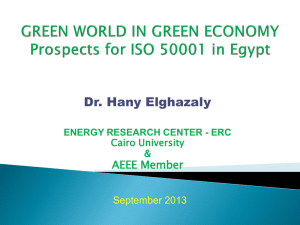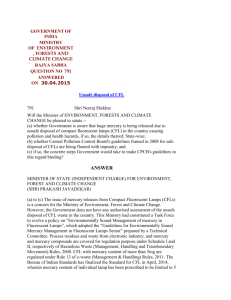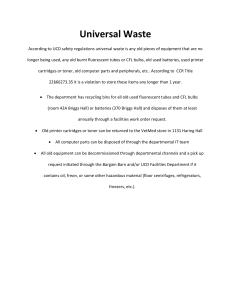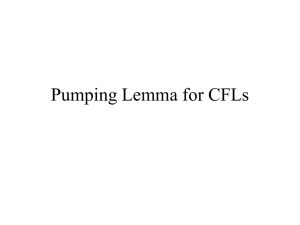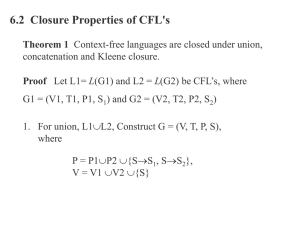SAVE ELECTRICITY, SAVE MONEY & MINIMIZE LOAD SHEDDING
advertisement
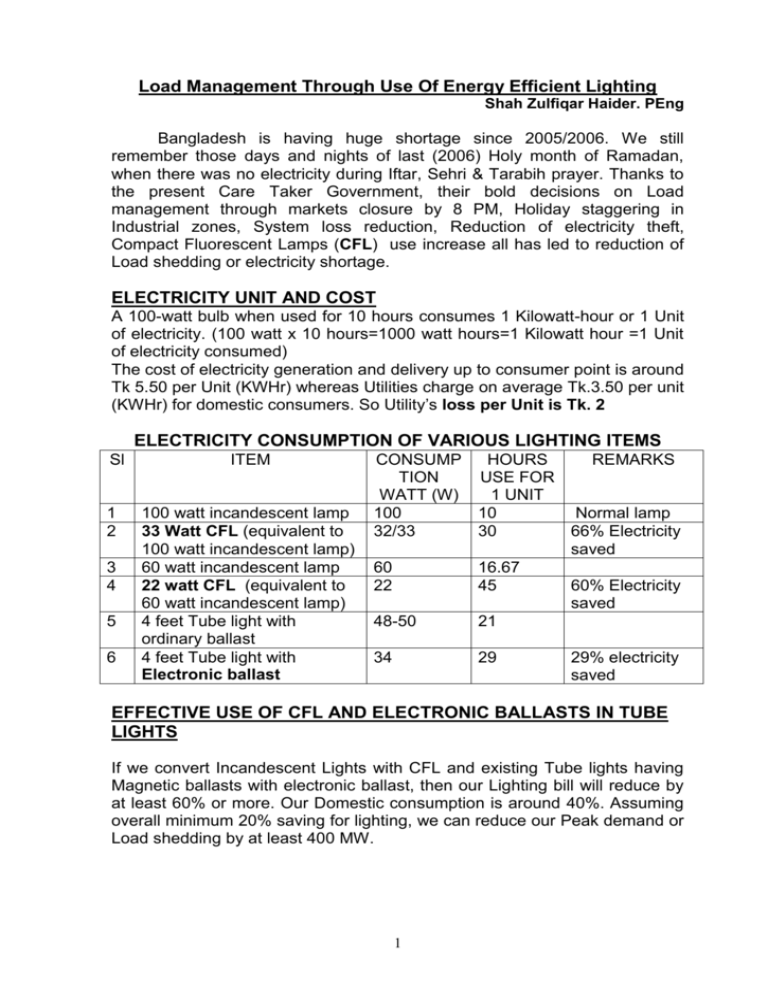
Load Management Through Use Of Energy Efficient Lighting Shah Zulfiqar Haider. PEng Bangladesh is having huge shortage since 2005/2006. We still remember those days and nights of last (2006) Holy month of Ramadan, when there was no electricity during Iftar, Sehri & Tarabih prayer. Thanks to the present Care Taker Government, their bold decisions on Load management through markets closure by 8 PM, Holiday staggering in Industrial zones, System loss reduction, Reduction of electricity theft, Compact Fluorescent Lamps (CFL) use increase all has led to reduction of Load shedding or electricity shortage. ELECTRICITY UNIT AND COST A 100-watt bulb when used for 10 hours consumes 1 Kilowatt-hour or 1 Unit of electricity. (100 watt x 10 hours=1000 watt hours=1 Kilowatt hour =1 Unit of electricity consumed) The cost of electricity generation and delivery up to consumer point is around Tk 5.50 per Unit (KWHr) whereas Utilities charge on average Tk.3.50 per unit (KWHr) for domestic consumers. So Utility’s loss per Unit is Tk. 2 ELECTRICITY CONSUMPTION OF VARIOUS LIGHTING ITEMS Sl 1 2 3 4 5 6 ITEM 100 watt incandescent lamp 33 Watt CFL (equivalent to 100 watt incandescent lamp) 60 watt incandescent lamp 22 watt CFL (equivalent to 60 watt incandescent lamp) 4 feet Tube light with ordinary ballast 4 feet Tube light with Electronic ballast CONSUMP HOURS REMARKS TION USE FOR WATT (W) 1 UNIT 100 10 Normal lamp 32/33 30 66% Electricity saved 60 16.67 22 45 60% Electricity saved 48-50 21 34 29 29% electricity saved EFFECTIVE USE OF CFL AND ELECTRONIC BALLASTS IN TUBE LIGHTS If we convert Incandescent Lights with CFL and existing Tube lights having Magnetic ballasts with electronic ballast, then our Lighting bill will reduce by at least 60% or more. Our Domestic consumption is around 40%. Assuming overall minimum 20% saving for lighting, we can reduce our Peak demand or Load shedding by at least 400 MW. 1 Incandescent lamp Compact Fluorescent Lamps (CFL) Normal incandescent lamps consume more than 90% electricity for heating and 10% for illumination, so avoid it. For lights used more than 4 hours a day, use Fluorescent or Compact Fluorescent lamps (CFL) or Energy Saving Lamps. It will save more than 66% electricity cost. Again incandescent lamps have 1000-hour life & CFL have 6,000-15,000 hours life. Slim tube lights give better light and save electricity. The following measures if adopted by the Government will save at least 400 MW of electricity at Consumer point, which is at least Tk 40,000 million from “Generation-transmission-distribution cost”. 1. CFL Warranty increase to 2 years. The CFL suppliers claim 6,000-10,000 hours life. Considering 8 hours a day use, it will last for 2-4 years. So it should have at least 2 years warranty. 2. Poor Power Factor & more harmonic distortion in cheap CFL. Most of the CFL available in country have poor Power factor around 60-70% & more Total Harmonic Distortion (THD). This is harmful when it is used in bulk. As a result savings in electricity is not wholly effective and it has adverse effect on electricity quality and generation. CFL with Poor Power Factor & more total harmonic distortion are discouraged worldwide. The Government should allow only CFL with minimum 90% power factor and THD below 30%. 3. Ban on production and import or sale on 60 & above wattage of Incandescent Lamps. 4. Reduction of VAT, Tax or Duty on CFL & Electronic Ballasts. 5. Environmental effect of CFL Mercury in a CFL lamp is harmful for our environment. The mercury content of a good quality CFL is 5-6 milligram. 1 cubic feet of soil can accommodate maximum 300 nanogram of mercury, so 1 CFL will require at least 589,000 cubic feet of soil! As such mercury content of CFL is hazardous. 2 6. Disposal of CFL after full use: Fluorescent lamps contain mercury, a toxic heavy metal, which mey require special disposal, separate from general and household wastes. Mercury poses the greatest hazard to pregnant women, infants, and children. Safe disposal required to store the bulb unbroken. A broken fluorescent lamp is more hazardous than a broken conventional incandescent bulb due to the mercury content. Government should ask CFL manufacturer and supplier to arrange safe Recycling facilities for CFL. Consumers should return it to the store from where it is purchased. 7. Tube Lights-Electronic ballast vs. Ordinary ballast. Electronic ballast saves at least 14 watts with same illumination. Only problem voltage fluctuation might damage the electronic ballast. So change all Magnetic ballasts to Electronic ballast 8. Restriction of Magnetic Ballast. Its import should be banned or discouraged imposing high taxes. But remember, Utilities are to provide better quality electricity (no low of fluctuating voltage) 9. Utilities concern-System loss increase & Revenue decrease. The electric meters used in our country does not fully read at so low wattage of CFL or Tube lights (11/15/18/20 watts), so there will be Less Meter Reading with CFL & Tube Lights than actually consumed, result “System loss increase and Revenue loss”. Remedy, Proportionate Tariff increase, Improved and sensitive meters may only be installed. In case of existing meters, estimated KWH per CFL of TL may be added. 10. There will be less heat emission in CFL leading to less Green house effect. In Australia, England etc all normal bulbs are being replaced by CFL. 11. The penetration of CFL even in houses of educated people, public Places/offices and Government buildings is very low. As a first step all Government owned buildings, institutions, Cantonments, should replace their Incandescent Lamps with CFL, Tube Light magnetic ballast with electronic ballast. The Government or respective institutions provide necessary budget. Then NGO, Private installations, Malls etc be requested for the same. 3 11. CFL on Loan to Consumers. It has been practiced in many Countries. CFL may be provided by Utilities on loan to the consumers. The recovery may be made from the equivalent amount of money saved for CFL in billing. 12. Garments one of largest consumer of Tube Lights. All Ballasts be replaced by Electronic ballast. They may be given loan for the same. MOTIVATION TO USE LESS ELECTRICITY Motivation is a key to success in today’s management. People are required to make understand that we are having shortage of electricity. Public might think they are paying genuinely, so why they should not be provided with adequate supply. Well if we are convinced and motivated about electricity saving and minimizing Load shedding, then we should follow these guidelines and motivate or convince others to follow it. If people in Europe, America can do it, then why can’t we? “SAVE ENERGY, SAVE THE ENVIRONMENT & SAVE MONEY” The author Shah Zulfiqar Haider, PEng is the First Registered Professional Engineer in REB/PBS, General Manager-Noakhali PBS with 26 years of Professional experience in Energy sector, TQM & Military Engineering Services. He is Member (Researcher) Global Development Network. He is also Member Network of Energy Advisors Linx Research NY (USA), American Council for an Energy-Efficient Economy (ACEEE), World Energy Council, Global Village Energy Partnership (UK), The Asia Pacific Forum for Sustainable Energy, House hold Energy Network, Bangladesh Society for Total Quality Management, Bangladesh Computer Society etc. Life Fellow-IEB, Life Member-South Asia Federation of AOTS Alumni Societies (Japan), Associate-Renewable Energy and Energy Efficiency Partnership UK. He has been to USA, China, Japan, India, Nepal etc on various professional visits. The author can be reached via Email. szhaider123@hotmail.com or Cell. 0152-307218. 4

